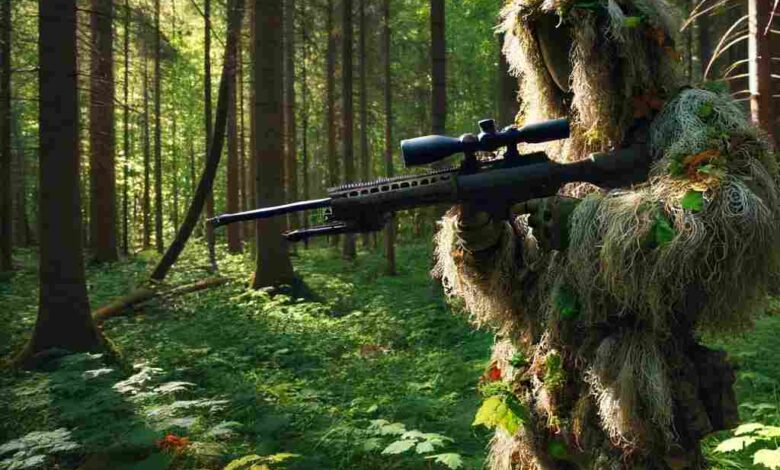Mastering Stealth: Advanced Techniques with a Ghillie Suit

The ghillie suit is one of the most important tools snipers, hunters, and even those who are just enthusiasts of the great outdoor can use to be able to master stealth in different scenarios. In this article we are going to take a look through the different parts of a ghillie suit, how to make them, what they are used for & where you can get them.
What is a Ghillie Suit?
A ghillie suit is a type of camouflage clothing designed to resemble the background environment such as foliage, snow, or sand. Designers primarily create a ghillie suit to eliminate the human outline, effectively concealing its wearer from view. Primarily used by military snipers, hunters, and wildlife photographers, who require optimal blending with surroundings.
Types of Ghillie Suits
Sniper Ghillie Suits: Usually front-less to allow for crawling and stitched together to meet military code. This includes knee, elbow, and chest padding for cushion during extended prone positions. Others also have built-in features like hydration systems and available pockets.
Hunting Ghillie Suits: Created for hunters – these suits are available in different styles – including woodland, desert, and winter camouflage. Lighter and more compliant ones that flex more easily to go through thick brush. This normally comes in the form of lightweight, sometimes synthetic material that forms 3D leaf patterns allowing for more flexibility and deeper breathability on them.
DIY Ghillie Suits: For hunters who prefer a more custom-tailored fit or even have budgetary constraints, making your own ghillie suit can be a fun little project. Basic materials needed are a base suit (Uniform BDU, etc.), jute or synthetic thread, netting, and natural (we respect and advocate artificial or synthetic plants, flowers, etc.) vegetation which are harvested locally in the theatrical production area. This means that the netting is attached to the suit and the jute or synthetic strands are then attached to the netting to allow space for the addition of the natural vegetation.
How to Make a Ghillie Suit
- Gather Materials: a bodysuit, netting, jute or nylon threads, a heavy duty sewing needle and natural items such as leaves, twigs, etc.
- Attach the Netting: Take the base suit and sew the netting in place so the entire suit is covered that you want camouflaged. Stitch the netting securely with strong threads.
- Add Jute/Synthetic Strands: Twist and tie strands of jute or synthetic around the netting. Lightly filled, the shorter lengths offer a subtler effect. Blend colors to match surroundings
- Add Natural Vegetation: Before going to the particular spot, fix natural vegetation to your suits. You should blend this in with the environment and change it as you travel through different areas.
Using a Ghillie Suit
After you have made your ghillie suit you must condition it. This procedure requires soaking the suit, and rolling on the mud and dirt for more realistic results They will then rub the entire suit down with mud, not only to graduate any artificial sheen but to also bring out any natural earth colors that may be on the wool. Use the suit by updating the pattern of natural vegetation you have so that it resembles as near as possible to your surroundings.
Where to Buy a Ghillie Suit
If you feel more buying a ghillie suit all set to go, there are lots on the market:
- Ghillie Suits: They offer custom-made ghillie suits that are designed as per customer needs with varying pattern options as well as the material is made of Cordura for longevity.
- North Mountain Gear: Budget-friendly quality 3D leafy ghillie suits that are breathable and comfortable for different weather conditions.
- Amazon: There are all kinds of ghillie suits, starting from budget and low-range up to the expensive suits worn by professional players.
Advanced Techniques with a Ghillie Suit
Blending Techniques: Blending Blend in with your natural surroundings, as this is the secret to good camouflage. This means getting to know the terrain, being aware of what mix to use in your suit, of natural materials and others not really natural. You need to adapt your current environment to your suit’s vegetation regularly if you wish for your camouflage to be effective.
Movement and Positioning: One of the most important things when you have a ghillie suit is to limit as much movement as possible. Avoid sight by moving slowly with extreme care, making use of heavy mud when possible. Be very observant of the background and avoid creating any harsh shadows that may give your location away while placing yourself.
Maintenance and Care: Is your ghillie suit receiving regular usage? This means giving it a good deep clean, checking out any signs of wear and tear, and replacing anything that is damaged or missing. A well-kept ghillie suit, kept out of sun and in a dry place, will last for many games.
The Bottom Line
Of course, there are lots of uses for a ghillie suit. If you are a sniper, hunter, or a wildlife photographer, knowing the ropes of making, using, and keeping a ghillie suit will greatly enhance your capability to be one with the surroundings. So long as you have the right materials and the best technique, you will be able to slink through various means undetected.




